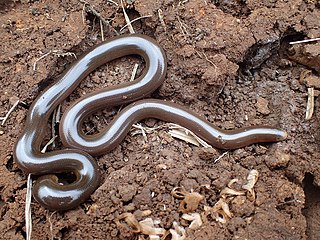
Uropeltis maculata, also known commonly as the spotted earth snake and the spotted shieldtail, is a species of nonvenomous snake in the family Uropeltidae. The species is endemic to southern India. There are no subspecies that are recognized as being valid.
Uropeltis nitida is a species of nonvenomous shieldtail snake. The species is endemic to southern India. There are no subspecies that are recognized as being valid.
Uropeltis ocellata is a species of non-venomous shieldtail snake in the family Uropeltidae. The species is indigenous to southern India. There are no subspecies that are recognized as being valid.
Uropeltis rubrolineata is a species of nonvenomous shieldtail snake in the family Uropeltidae. The species is endemic to southern India. There are no subspecies that are recognized as being valid.

Uropeltis rubromaculata is a species of nonvenomous shieldtail snake in the family Uropeltidae. The species is endemic to southern India. There are no subspecies that are recognized as being valid.
Letheobia simonii is a blind snake species endemic to the Middle East. No subspecies are currently recognized.
Rhinophis philippinus, also known as Peter's earth snake or Peter's Philippine earth snake, is a species of snake in the family Uropeltidae. It is endemic to Sri Lanka.
Polemon gabonensis, or the Gaboon snake-eater, is a species of mildly venomous rear-fanged snake in the family Atractaspididae. It is endemic to Africa.
Polemon gracilis, or the graceful snake-eater, is a species of mildly venomous rear-fanged snake in the family Atractaspididae. It is endemic to Africa.
Anomalepis mexicana is a species of snake in the Anomalepididae family.

Leptotyphlops nigricans, also known as the black threadsnake or black worm snake, is a species of snake in the family Leptotyphlopidae. It is endemic to Africa.
Aparallactus jacksonii, or Jackson's centipede-eater, is a species of mildly venomous rear-fanged snake in the family Atractaspididae.
Aparallactus werneri, or the Usambara centipede-eater, is a species of mildly venomous rear-fanged snake in the family Lamprophiidae. The species is endemic to Tanzania.
Cross's beaked snake is a species of snake in the family Typhlopidae. The species is native to West Africa.

Rhinotyphlops schinzi, commonly known as Schinz's beaked blind snake, is a species of snake in the family Typhlopidae. The species is endemic to southern Africa.
Rhinotyphlops unitaeniatus, commonly known as the yellow-striped blind snake or the Kenya beaked snake, is a species of snake in the Typhlopidae family. It is endemic to Africa.

Bibron's blind snake is a species of snake in the family Typhlopidae. The species is native to southern Africa.
Fornasini's blind snake is a species of snake in the family Typhlopidae. The species is endemic to southern Africa.
The Malawi blind snake, also known as the slender blind snake or southern gracile blind snake, is a species of snake in the Typhlopidae family. It is endemic to Africa.

Afrotyphlops schlegelii, commonly known as Schlegel's beaked blind snake or Schlegel's giant blind snake, is a species of snake in the family Typhlopidae. The species is endemic to eastern and southern Africa, and bears the distinction of being the world's largest typhlopid. It is harmless to humans and lives exclusively on a diet of termites.





